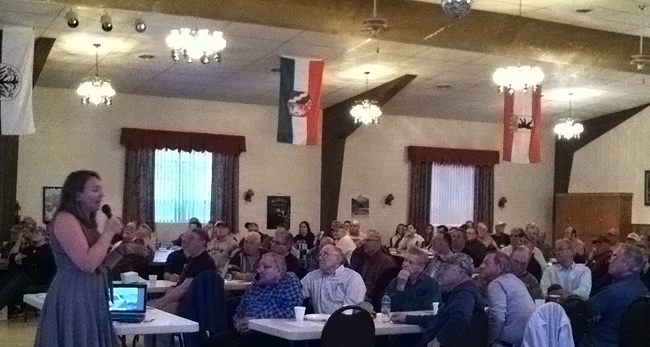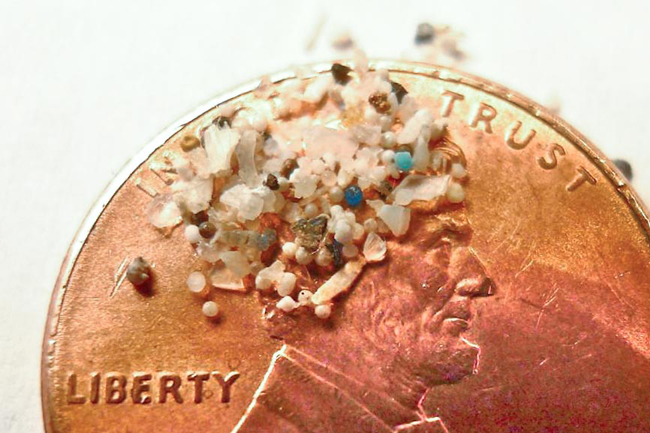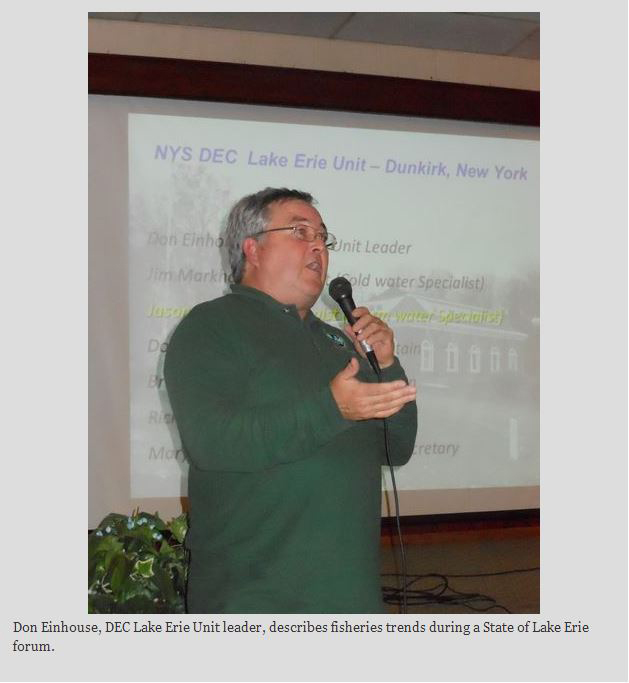Buffalo, NY, May 1, 2014 - Every April, NYSG's Coastal Education Specialist Helen Domske coordinates a State of Lake Erie meeting in Hamburg, NY. The event—the 21st of its kind, attracting well over 200 anglers and interested citizens annually—is planned in partnership with the New York State Department of Environmental Conservation and in cooperation with New York State Assembly member Sean Ryan as well as the Southtowns Walleye Association of Western New York.
During this year's annual two hour discussion, Domske provided attendees with an update on Lake Erie's toxic algae blooms, which is one of today's most pressing issues, especially in the Lake's shallow western basin. In these locales, harmful algal blooms (HABs) have changed the Lake's once clear waters into a bright green soup.
“It’s been mainly a problem in Ohio waters in the Western Basin, but it has now been seen as close as Presque Isle Bay in Pennsylvania,” said Domske, adding that not all algae growth is toxic, but swimmers are cautioned to avoid waters in which these growths are seen. Excess presence of algae can be harmful even after death, decreasing oxygen levels for fish and other aquatic life.
As detailed in NYSG's related fact sheet, "Lake Erie" (pdf), though, HABs are not new to Lake Erie. Ohio Sea Grant, one of NYSG's Great Lakes Sea Grant partner programs, also offers information on the topic via a four-page fact sheet, "Harmful Algal Blooms in Ohio Waters" (pdf). Includes are answers to the questions "What causes HABs to form?" and "What can I do about it?"

Dr. Sherri A. Mason, a presenter at the 2014 State of Lake Erie meeting. Photo: Helen Domske/NYSG
One of the featured speakers invited by Domske, Dr. Sherri A. Mason (pictured above, presenting at the meeting), an Associate Professor of Chemistry and Environmental Sciences Program Coordinator at SUNY Fredonia, presented on microplastics in Lake Erie and their impacts on fish health. Mason’s “Great Lakes Plastic Pollution Survey” studies key on all the plastics found in waters, and 80 percent consist not of plastic sheeting or bottles but of small fibers, particles and pellets that enter waterways from washing synthetic clothing, a problem experts need to address.
Later this month, Mason will be a guest speaker on the topic of plastic pollution and solutions for middle through high school classrooms during a webinar hosted by the New York State Marine Education Association, a partner of New York Sea Grant. The lecture, "Oceans of Plastic—From Science to Solutions," is slated for May 29th at 10:30 am and is limited to 50 participating classrooms. For more information see the event flyer (pdf).
"For years people have worried about the environmental impacts from plastics left behind in the oceans and Great Lakes," writes NYSG's Domske in a recently-released NYSG fact sheet on the subject. "Pictures of birds tangled in six-pack rings or turtles choking on plastic bags have documented the danger of discarded plastics that linger in the environment. Recently, attention has turned to the Great Lakes and small plastic particles and microbeads that have been found there. Some plastic particles result from the breakdown of larger plastic items, but others are small plastic spheres known as microbeads."
This past January, Mason furthered the conversation on National Public Radio's The Leonard Lopate Show during a 20-minute-plus "Microplastics in our Water" discussion. In his introduction of the topic, Lopate said, "Microbeads, the tiny pieces of plastic commonly used in personal care products, are showing up in waterways across the nation. These tiny particles are considered potentially dangerous to the environment because of their tendency to absorb toxins in the water and then get consumed by fish and other organisms."

A collection of microplastics can take up a small amount of real estate on the head of a penny. Photo: 5Gyres.org
During the talk, which can be streamed in its entirety below, Mason says these microbeads "can actually be down to four micrometers in size and can go up to about 1.2 millimeters, so the size range is pretty wide."
Where might someone come across these microplastics? "They're quite noticeable to people when they're walking down their grocery store aisles and come across some of the facial washes with brightly-colored beads suspended within the clear liquid," says Mason. "They [microplastics/microbeads] become a feature way of attracting people to products ... But once they are in the water, [these [microplastics/microbeads] can become very hard to detect by the naked eye."
Do these microplastics tend to stick together when they wash down the drain or do they disperse? "The do disperse, but tend to coagulate with living materials that are in the bodies of water," says Mason. "So, for example, we find when we pull in our nets meshed within the vascular plants [those land plants that have lignified tissues for conducting water and minerals throughout the plant] is that debris - hundreds, thousands of these little micro-particles of plastic. Being able to conceive how many is very difficult ... and trying to clean it out would kill the entire ecosystem, as they are so enmeshed with the water's living materials."
"In the Great Lakes, we have done some samples on fish, examining their stomach contents, in which we have found little bits of plastic." Next up, Mason says she and her team will be doing an analysis on birds to see if they, too, have been impacted by this emerging issue.
"[Microplastics] are definitely making their way into the food chain and migrating their way up," says Mason. "And, the fact that they absorb toxins from the water supply, the plastics can act as a way to move these chemicals from the water and into organisms."
On Air: National Public Radio's The Leonard Lopate Show—
"Microplastics in our Water" (January 30, 2014)
WNYC 93.9 FM and AM 820, a division of New York Public Radio, are New York's flagship public radio stations, broadcasting programming from NPR and Public Radio International, as well as a wide range of award-winning local programming.
If you don't see the player above, it's because you're using a
non-Flash device (eg, iPhone or iPad). You can download the mp3 file by clicking here (mp3). It may take a few minutes to download, so please be patient.
Anti-Microplastics Legislation and What You Can Do To Help
In mid-March, a bill was introduced in Illinois that was similar to newly-introduced legislation in New York and California. About a month prior to this legislation surfacing in Illinois, New York became the first in the nation to propose legislation for microbead-free waters.
Robert Sweeney, a Suffolk County, Long Island Assemblyman, brought forth New York's legislation this past February on behalf of Attorney General Eric T. Schneiderman to prohibit the sale of cosmetic and beauty products that contain the beads, which are added to aid exfoliation and abrasion.
Sweeney, who is chairman of the Assembly’s environmental conservation committee, told The New York Times, “When people learn more about this issue, they will be unwilling to sacrifice water quality just to continue to use products with plastic microbeads.”
“From the Great Lakes to the Hudson River to Long Island Sound, our commitment to protecting and restoring New York’s waters is among our most important responsibilities,” added Schneiderman.
So, aside from supporting legislative acts to ban the sue of these plastics in commonly-used products, what can you do, as a consumer, to be more 'microplastic-conscious'? While we wait for science and the government to educate and legislate on the topic, Mason says, "We can all make a choice today to change our purchasing habits, and ban the microbeads and other plastics from our own lives. Maybe not in totality, but we can definitely be aware of those single-use plastic products - things like bags, straws and water bottles. When you talk about there being seven billion people on the planet, those small steps can have a huge impact."
Being aware is key, as microbeads are commonly found in hundreds of products, including facial scrubs, soaps, shampoos and toothpastes, where they are used as a synthetic alternative to natural abrasives such as ground almonds, oatmeal and pumice. On product labels, look out for polyethylene and polypropylene, the two most common plastics used to make the microbeads. Mason also says there are also smartphone apps that have been developed to offer consumers more information about the presence of plastic materials in personal care products.
For more on NYSG's efforts to educate on the topic, see the two-page "Plastic Microbeads in the Great Lakes" fact sheet (pdf).
Other Discussions at the State of Lake Erie Meeting
Talks given by, respectively, NYSDEC Lake Erie Unit Leader Don Einhouse and U.S. Fish and Wildlife Service (USFWS) Fish Biologist Dr. Dimitry Gorsky, centered on the status of the Lake's fish community and the search for Lake Sturgeon. Also, Aquatic biologist Jim Markham presented on the Lake Erie cold-water fishery.
As reported by Will Elliott, a reporter from The Buffalo News, anglers got some good news about walleye and perch prospects and other topics during the State of Lake Erie meeting at the Southtowns Walleye Association clubhouse.

Photo: Will Elliott/The Buffalo News
Don Einhouse, state Department of Environmental Conservation’s Lake Erie Unit leader, focused on study results of catches, catch rates and angler efforts charted during the last 25 years.
A yearly angler survey conducted at boat-launch ramps and fish-cleaning stations showed some interesting trends from 1988 to 2013. Walleye fishing, at its peak, had once been 70 percent of angler efforts.
Walleye remain a popular target with excellent year classes of hatching survival in 2003 and 2010. The 2013 survey had 46 percent of anglers fishing for ’eyes; 21 percent went out for perch and 20 percent sought smallmouth bass last year.
“Bass numbers continue up, mainly in the spring when most fishing trips are catch-and-release outings,” Einhouse said.
Perch catch rates and angler efforts have been improving since 2000. Previously, the 1988 peak in perch populations declined through the 1990s such that few anglers targeted yellow perch until after 2000. Catch numbers recorded for 2012 approximate the 1988 count, but year classes anglers might see in 2014 will include smaller fish from recent hatching-year successes.
“It might be a good idea to keep perch large enough to fillet,” Einhouse said of so many fish caught and brought up from deeper waters.
He also made reference to this past winter, noting that walleye, perch and whitefish hatching successes tend to be best during harsh winters and poor when winters are mild. This past severe winter could see a decline in alewife and gizzard shad populations.
In general, with good results shown from recent Lake Erie Unit studies in 2010 and 2012, fish species should be abundant and healthy. Einhouse expects anglers to have a good fishing season in 2014.
Dimitry Gorsky reported on the increasing numbers of lake sturgeon that his U.S. Fish and Wildlife Service surveys reveal each year.
“A sturgeon can live up to 150 years, does not begin reproducing until at and after age 13 and averages a 6-foot length and about 100 pounds,” Gorsky said of Lake Erie sturgeon studied.
The lake sturgeon is a protected fish species in Lake Erie. Anglers can be cited with a violation for targeting them while fishing. But Gorsky said that the USFWS would like anglers to report sightings of sturgeon anywhere in area waters.
— Paul C. Focazio, NYSG's Web Content Manager
More Info: New York Sea Grant
New York Sea Grant (NYSG), a cooperative program of Cornell University
and the State University of New York, is one of 33 university-based
programs under the National Sea Grant College Program (NSGCP) of the
National Oceanic and Atmospheric Administration (NOAA). The NSGCP
engages this network of the nation’s top universities in conducting
scientific research, education, training and extension projects designed
to foster science-based decisions about the use and conservation of our
aquatic resources. Through its statewide network of integrated
services, NYSG has been promoting coastal vitality, environmental
sustainability, and citizen awareness about the State’s marine and Great
Lakes resources since 1971.
For updates on Sea Grant activities: www.nyseagrant.org has RSS, Facebook, Twitter, and YouTube links. NYSG also offers a free e-list sign up via www.nyseagrant.org/coastlines for NY Coastlines, its flagship publication, which, in 2014, merges with the program's e-newsletter, Currents. NY Coastlines is published several times a year.